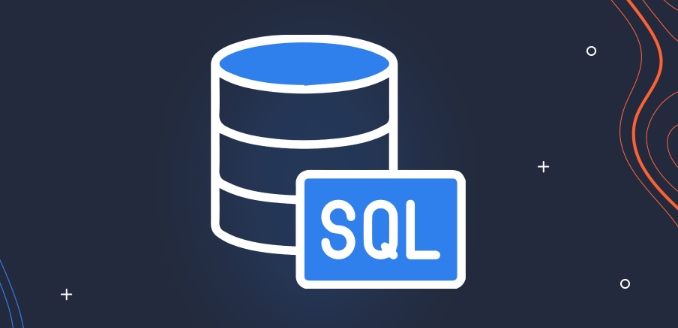The main difference between WHERE and HAVING is the filtering timing: 1. WHERE filters rows before grouping, acting on the original data, and cannot use the aggregate function; 2. HAVING filters the results after grouping, and acting on the aggregated data, and can use the aggregate function. For example, when using WHERE to screen high-paying employees in the query, then group statistics, and then use HAVING to screen departments with an average salary of more than 60,000, the order of the two cannot be changed. WHERE always executes first to ensure that only rows that meet the conditions participate in the grouping, and HAVING further filters the final output based on the grouping results.

The difference between WHERE and HAVING in SQL comes down to when each filter is applied — especially in relation to grouping. In short:

-
WHEREfilters rows before they are grouped. -
HAVINGfilters groups or aggregated results after the grouping is done.
If you're using GROUP BY , that's where this distinction really matters.

Filtering Before Grouping with WHERE
Use WHERE when you want to narrow down which rows go into the grouping process. It works on individual rows, not aggregated values.
For example:

SELECT department, COUNT(*) AS employee_count FROM employees WHERE salary > 50000 GROUP BY department;
Here, only employees earning more than $50k are included before the database groups them by department. The filtering happens early, so it affects the final counts.
You can't use aggregate functions like COUNT() , SUM() , etc., in a WHERE clause — because those values ??don't exist yet at that stage of the query.
Key points:
- Filters raw data.
- Cannot reference aggregate functions.
- Runs before grouping.
Filtering After Grouping with HAVING
Once you've grouped your data using GROUP BY , you might want to filter based on the result of an aggregation — that's where HAVING steps in.
Example:
SELECT department, COUNT(*) AS employee_count FROM employees GROUP BY department HAVING COUNT(*) > 10;
This query returns only departments with more than 10 employees. The count is calculated first, then filtered.
Unlike WHERE , HAVING can include aggregate functions. You can also reference column aliases defined in the SELECT .
Common uses:
- Filter based on group size (
COUNT,SUM, etc.) - Compare aggregated values ??(eg,
HAVING AVG(salary) > 60000) - Use with or without
GROUP BY
When to Use Which?
To decide between WHERE and HAVING , ask yourself:
- Do I need to filter individual rows before grouping? → Use
WHERE. - Do I need to filter groups or aggregated results after grouping? → Use
HAVING.
Sometimes both can be used together:
SELECT department, AVG(salary) AS avg_salary FROM employees WHERE status = 'active' GROUP BY department HAVING AVG(salary) > 60000;
In this case:
-
WHEREnarrows the dataset to active employees only. -
HAVINGfurther filters the resulting groups to show only those with an average salary over $60k.
So basically, it's about timing: WHERE filters early, HAVING filters late — especially useful after aggregations.
The above is the detailed content of What is the difference between WHERE and HAVING clauses in SQL?. For more information, please follow other related articles on the PHP Chinese website!

Hot AI Tools

Undress AI Tool
Undress images for free

Undresser.AI Undress
AI-powered app for creating realistic nude photos

AI Clothes Remover
Online AI tool for removing clothes from photos.

Clothoff.io
AI clothes remover

Video Face Swap
Swap faces in any video effortlessly with our completely free AI face swap tool!

Hot Article

Hot Tools

Notepad++7.3.1
Easy-to-use and free code editor

SublimeText3 Chinese version
Chinese version, very easy to use

Zend Studio 13.0.1
Powerful PHP integrated development environment

Dreamweaver CS6
Visual web development tools

SublimeText3 Mac version
God-level code editing software (SublimeText3)

Hot Topics
 What is the difference between HQL and SQL in Hibernate framework?
Apr 17, 2024 pm 02:57 PM
What is the difference between HQL and SQL in Hibernate framework?
Apr 17, 2024 pm 02:57 PM
HQL and SQL are compared in the Hibernate framework: HQL (1. Object-oriented syntax, 2. Database-independent queries, 3. Type safety), while SQL directly operates the database (1. Database-independent standards, 2. Complex executable queries and data manipulation).
 Comparison and differences of SQL syntax between Oracle and DB2
Mar 11, 2024 pm 12:09 PM
Comparison and differences of SQL syntax between Oracle and DB2
Mar 11, 2024 pm 12:09 PM
Oracle and DB2 are two commonly used relational database management systems, each of which has its own unique SQL syntax and characteristics. This article will compare and differ between the SQL syntax of Oracle and DB2, and provide specific code examples. Database connection In Oracle, use the following statement to connect to the database: CONNECTusername/password@database. In DB2, the statement to connect to the database is as follows: CONNECTTOdataba
 Usage of division operation in Oracle SQL
Mar 10, 2024 pm 03:06 PM
Usage of division operation in Oracle SQL
Mar 10, 2024 pm 03:06 PM
"Usage of Division Operation in OracleSQL" In OracleSQL, division operation is one of the common mathematical operations. During data query and processing, division operations can help us calculate the ratio between fields or derive the logical relationship between specific values. This article will introduce the usage of division operation in OracleSQL and provide specific code examples. 1. Two ways of division operations in OracleSQL In OracleSQL, division operations can be performed in two different ways.
 Detailed explanation of the Set tag function in MyBatis dynamic SQL tags
Feb 26, 2024 pm 07:48 PM
Detailed explanation of the Set tag function in MyBatis dynamic SQL tags
Feb 26, 2024 pm 07:48 PM
Interpretation of MyBatis dynamic SQL tags: Detailed explanation of Set tag usage MyBatis is an excellent persistence layer framework. It provides a wealth of dynamic SQL tags and can flexibly construct database operation statements. Among them, the Set tag is used to generate the SET clause in the UPDATE statement, which is very commonly used in update operations. This article will explain in detail the usage of the Set tag in MyBatis and demonstrate its functionality through specific code examples. What is Set tag Set tag is used in MyBati
 What does the identity attribute in SQL mean?
Feb 19, 2024 am 11:24 AM
What does the identity attribute in SQL mean?
Feb 19, 2024 am 11:24 AM
What is Identity in SQL? Specific code examples are needed. In SQL, Identity is a special data type used to generate auto-incrementing numbers. It is often used to uniquely identify each row of data in a table. The Identity column is often used in conjunction with the primary key column to ensure that each record has a unique identifier. This article will detail how to use Identity and some practical code examples. The basic way to use Identity is to use Identit when creating a table.
 How to solve the 5120 error in SQL
Mar 06, 2024 pm 04:33 PM
How to solve the 5120 error in SQL
Mar 06, 2024 pm 04:33 PM
Solution: 1. Check whether the logged-in user has sufficient permissions to access or operate the database, and ensure that the user has the correct permissions; 2. Check whether the account of the SQL Server service has permission to access the specified file or folder, and ensure that the account Have sufficient permissions to read and write the file or folder; 3. Check whether the specified database file has been opened or locked by other processes, try to close or release the file, and rerun the query; 4. Try as administrator Run Management Studio as etc.
 How to use months_between in SQL
Jan 25, 2024 pm 03:23 PM
How to use months_between in SQL
Jan 25, 2024 pm 03:23 PM
MONTHS_BETWEEN in SQL is a common function used to calculate the month difference between two dates. How it is used depends on the specific database management system.
 Database technology competition: What are the differences between Oracle and SQL?
Mar 09, 2024 am 08:30 AM
Database technology competition: What are the differences between Oracle and SQL?
Mar 09, 2024 am 08:30 AM
Database technology competition: What are the differences between Oracle and SQL? In the database field, Oracle and SQL Server are two highly respected relational database management systems. Although they both belong to the category of relational databases, there are many differences between them. In this article, we will delve into the differences between Oracle and SQL Server, as well as their features and advantages in practical applications. First of all, there are differences in syntax between Oracle and SQL Server.






